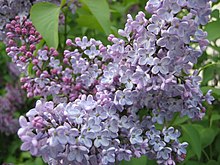Our website is made possible by displaying online advertisements to our visitors.
Please consider supporting us by disabling your ad blocker.
Syringa
| Syringa | |
|---|---|

| |
| Syringa vulgaris, common lilac | |
| Scientific classification | |
| Kingdom: | Plantae |
| Clade: | Tracheophytes |
| Clade: | Angiosperms |
| Clade: | Eudicots |
| Clade: | Asterids |
| Order: | Lamiales |
| Family: | Oleaceae |
| Tribe: | Oleeae |
| Subtribe: | Ligustrinae |
| Genus: | Syringa L. |
| Synonyms[1] | |
| |
Syringa is a genus of 12 currently recognized species of flowering woody plants in the olive family or Oleaceae[1] called lilacs. These lilacs are native to woodland and scrub from southeastern Europe to eastern Asia, and widely and commonly cultivated in temperate areas elsewhere.[2][3][4][5]
The genus is most closely related to Ligustrum (privet), classified with it in Oleaceae tribus Oleeae subtribus Ligustrinae.[6]
Lilacs are used as food plants by the larvae of some moth species, including lilac leaf mining moth,[7] privet hawk moth,[8] copper underwing, scalloped oak and Svensson's copper underwing.
- ^ a b "Syringa L. Sp. Pl. : 9 (1753)". World Flora Online. World Flora Consortium. 2022. Retrieved 10 December 2022.
- ^ Flora Europaea: Syringa
- ^ Flora of China: 丁香属 ding xiang shu Syringa
- ^ Flora of Pakistan: Syringa
- ^ Germplasm Resources Information Network: Syringa Archived 21 January 2009 at the Wayback Machine
- ^ University of Oxford, Oleaceae information site: New classification of the Oleaceae
- ^ "Lilac leaf mining moth / RHS Gardening". www.rhs.org.uk. Retrieved 12 May 2024.
- ^ "Privet Hawk-moth". butterfly-conservation.org. Retrieved 12 May 2024.
Previous Page Next Page


